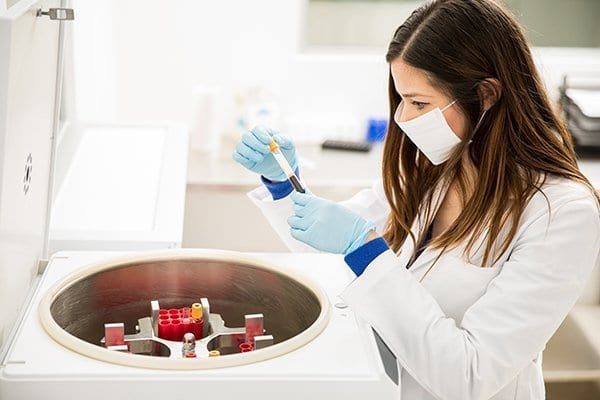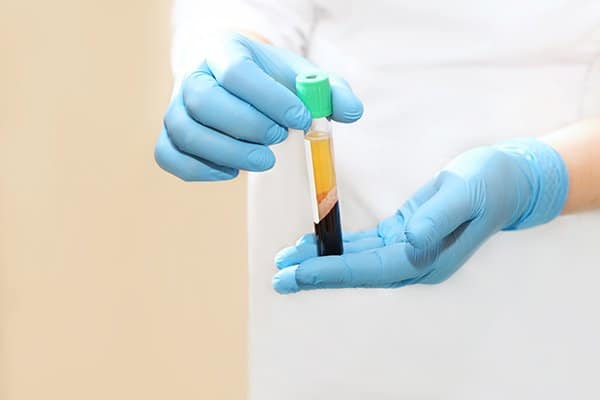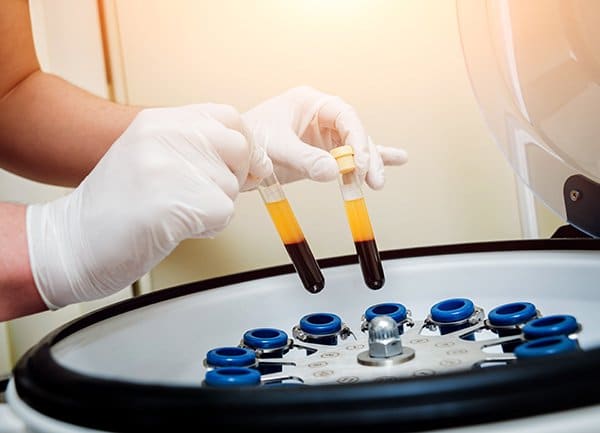PRP Labs is an authorized distributor of EmCyte PRP Kits. Therefore, the contents of this page are an advertisement. We strive to be objective and transparent.
Platelet recovery and platelet viability are two of the most pertinent aspects to consider when choosing a platelet concentrating system. Orthopedic and aesthetic surgeons have utilized the regenerative benefits of platelet rich plasma (PRP) since the 90’s. PRP has continued to gain in popularity as clinical trials consistently find that PRP can effectively speed the healing process in damaged tissues. This regenerative modality works by releasing potent growth factors at the site of injury. The efficacy of PRP procedures depends on accurately administering a therapeutic dose of platelets, which requires an effective concentrating system. This article compares two commercially available concentration systems; EmCyte Pure PRP kits and the Angel system. Comparative parameters include platelet concentration, growth factor release and the role of anticoagulants in the PRP preparation process.
How Does PRP Regenerate Tissue?
PRP is an autologous preparation which has been shown effective in clinical trials to help treat a wide variety of sports related injuries, degenerative conditions and aesthetic concerns including; epicondylitis, patellar tendinopathy, rotator cuff injuries, spinal fusion surgeries, c-section deliveries, hip osteoarthritis, Achilles’ tendinopathy, acne scar treatment, and hair loss reversal. When viable platelets are placed at the site of injury, they aggregate and Alpha-granules begin to degranulate and release growth factors. Platelet aggregation stops blood loss in severed vessels while growth factor release plays an essential role in wound healing. Growth factors such as transforming growth factor beta, vascular endothelial growth factor, and platelet derived growth factor can increase cartilage regeneration, angiogenesis, and regulate chemotaxis and mitosis in a variety of cells including mesenchymal stem cells, osteoblasts, chondrocytes and fibroblasts.¹
Interested in Purchasing EmCyte PRP Equipment? Click Here to Learn More
Assessing Commercial PRP Kits

Platelet concentration and growth factor release are vital for effective PRP treatments, so which PRP kit most effectively concentrates viable platelets? Researchers at BioSciences Research Associates (BSR) conducted a comparative analysis to assess the efficacy of commercially available PRP kits. BSR is an independent contract research laboratory located in Cambridge and once academically affiliated with Harvard Medical School. BSR is currently affiliated with the Immune Disease Institute at Harvard and as such draws from a community of nearly 400 bioscience researchers. The BSR laboratory complies with the Food and Drug Administration’s (FDA) Current Good Manufacturing Practice (cGMP) to assist pharmaceutical and biotech companies in product development and clinical trial support.²
Researchers lead by Robert Mandel PhD, collected up to 160 ml of blood from 7 unique donors and analyzed the efficacy of each PRP system in a paired sample design. All donors were healthy and met the donor requirements of the American Association of Blood Banks (AABB) and the FDA Center for Biologics Evaluation and Research. Blood was drawn with a 60cc syringe, preloaded with anticoagulant according to the kit manufacturers guidelines; 10 ml of sodium citrate per 50 ml of blood in the EmCyte Pure PRP system and 8 ml of Anticoagulant Citrate Dextrose Solution A (ACDA) per 52 ml of blood in the Atherex Angel system. Researchers continued to follow manufacturer’s centrifugation guidelines to yield a concentrated PRP serum.
Which PRP System Outperforms the Other?

The study assessed platelet concentration factor, platelet yield, and growth factor release under thrombin activation, among other parameters. Platelet concentration factor is the ratio of the concentration of platelets in the final PRP product to the concentration of platelets in the start sample, with adjustments for anticoagulant dilution. Platelet concentration was assessed by conducting complete blood counts with a 3-part differential hematology analyzer. Statistical analysis revealed a mean platelet recovery rate of 81% in the EmCyte Pure PRP system compared to 49% in the Atherex Angel system, which translates to a platelet concentration factor of 7x baseline in the EmCyte PRP system and 4.1x for the Atherex Angel serum. This disparity in platelet concentration could be attributed to the unique design of each system and may also be related to the use of completely different anticoagulants.
Do Anticoagulants Affect Platelet Recovery?

All PRP preparation techniques start with a blood draw in the presence of an anticoagulant agent. Anticoagulants prevent platelet activation during the mechanical force of centrifugation. If platelets where to activate during the preparation process a clot would form, growth factors would release. The resulting fibrin matrix would contain no more platelets than whole blood and would no longer be injectable. As the use of an anticoagulant is necessary in the preparation process, it’s valuable to understand the effects of various anticoagulants.
Researchers in Brazil evaluated the effect of three known anticoagulants on platelet recovery and growth factor release, ethylenediaminetetraacetic acid (EDTA), sodium citrate and ACDA. Hematological analysis revealed the highest platelet recovery rate in serums developed with sodium citrate (81.21%) followed by EDTA (76.15%) then ACDA (45.71%). Growth factor release was quantified with ELISA kits. The study revealed similar levels of Transforming Growth Factor Beta and Vascular Endothelial Growth Factor (VEGF) in all three anticoagulants. Levels of Platelet Derived Growth Factor (PDGF) were highest in the serums obtained with EDTA (though closely followed by sodium citrate) which could suggest that platelets obtained with EDTA are more viable.³
Platelet Viability and Platelet Recovery in EmCyte and Angel PRP Kits
EDTA is commonly utilized in a laboratory setting while sodium citrate and ACDA are often employed in commercially available PRP kits. Though the aforementioned study suggests that samples obtained with EDTA would positively influence the performance of PDGF (and therefore osteoblasts), EDTA is not necessarily the best choice for a blood product that is meant to be reintroduced into the human body. EDTA is a better option for long term preservation as the D (dextrose) in EDTA provides nourishment for cells in storage. Additionally, the researchers found the average platelet volume increased with each successive centrifugation in the EDTA group. This suggests a change in morphology which could affect how the platelets behave in vivo.
Delivering a therapeutic dose of viable platelets is essential to the success of PRP therapy. Each step in the PRP process affects the outcome of the final product. Selecting a commercially available kit which effectively concentrates platelets will safely improve patient outcomes. According to research conducted by BSR and the Brazilian team assembled by Ronaldo Jose Farias Corrêa do Amaral, EmCyte Pure PRP achieves a higher platelet recovery compared to the Atherex Angel system. Based on the evidence collected by comparing the role of anticoagulants in platelet recovery, the statistically significant difference observed between the EmCyte and Angel systems may be related to the preferred anticoagulant.

Get an Instant Quote:
*We Typically Call Within 15 Minutes!
You Can Also:
- Dhurat R, Sukesh M. Principles and Methods of Preparation of Platelet-Rich Plasma: A Review and Author’s Perspective. Journal of Cutaneous and Aesthetic Surgery. 2014;7(4):189-197. doi:10.4103/0974-2077.150734.[ncbi]
- Mandel R. Report 515 Research Study: Comparisons of Emcyte Pure PRP II 2015, Harvest/Terumo APC60/Clear PRP, and Arthrex Angel PRP Products. Biosciences Research Associates. 2016; June 2015.[pdf]
- DCorrêa do Amaral R, Pereira da Silva N, Haddad N, Lopes L, Ferreira F, Filho R, Cappelletti P, Mello W, Cordeiro-Spinetti E, and Balduino A. Platelet-rich plasma obtained with different anticoagulants and their effect on platelet numbers and mesenchymal stromal cells behavior in vitro. Stem Cells International. 2016; Article ID 7414036, 11 pages.[ncbi]





